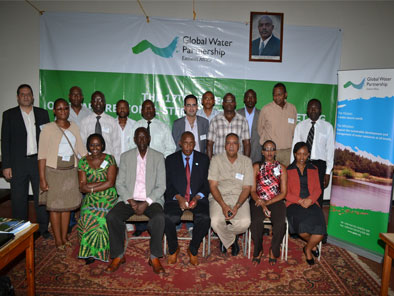The reports to be validated in April 2013 by multi-stakeholders from the nine countries and GWP Eastern Africa will present country-specific social, economic, policy, institutional and livelihoods framework within which climate resilience and adaptation programs of action will have to be designed and implemented for basin wide impact.
Commissioned by GWP Eastern Africa, the country climate resilience status reports are partial components of the five year project titled “Adapting to Climate Change Induced Water Stress in the Nile Basin.” The project first phase runs from 2009-2013.
The project covers Kenya, Egypt, Ethiopia, Eritrea, Uganda, Tanzania, Rwanda, Burundi and Democratic Republic of Congo and is funded by the Swedish Government and coordinated by the United Nations Environment Program (UNEP), Danish Hydraulic Institute (DHI) and it is implemented by the GWP Eastern Africa in partnership with a consortium of other institutions.
Though the nine countries have specific variations in cultures, policies and practices and institutional frameworks, climate change was noted as a across-cutting factor impacting their socio-economic livelihoods mainly agriculture, food security, hydro-energy production, water quantity and quality as well as mining safety and costs.
The report clearly recommends Governments to drive the climate change agenda, increase awareness, change behaviors, develop early warning systems and using multi-institutional and sectoral approach in responding climate change and carbon free development models.
“Traditional mindset, poverty and inadequate information sharing and awareness raising present significant barriers to addressing adaptation in Rwandan communities,” Rwanda’s Climate Resilience Status Report indicated.
As for Rwanda’s neighbor in East, Tanzania, the report points out that “lack of national climate change strategy has resulted into fragmented and piecemeal progress on climate activities in the country.”
Tanzania’s growing population (34.6 Million) majorly derives its livelihoods from agriculture, hunting, fishing, and forestry—the activities closely dependent on climatic conditions.
With 33.42 million people and successive historical droughts, the semi-desert Sudan has not “well integrated climate change adaptation into the national development plans, ” the report noted.
Thus, to remedy this, the Sudan climate resilience status report recommends: developing a national climate change resilience strategy, land use plans, development of a national early warning system and increasing awareness and behavior change activities.
Although the leadership in Ethiopia is internally lauded for adopting a climate resilient Green Economy, facts from the National Meteorological Agency draw a mixed picture in as far climate change is concerned.
For instance, the Ethiopia Climate Resilience Status Report underlined that “the country experienced 10 wet years and 11 dry years over the last 55 years—demonstrating the strong variability in climate.” Identified challenges in Ethiopia include financing, limited involvement of private sector in climate change discussion platforms and persistent and prolonged droughts and flood damages.
Reacting to the reports, GWP Eastern Africa’s Program Manager, ‘Kidanemariam Jembere said that “the reports will help GWP Eastern Africa and Country Water Partnerships to conduct informed actions aimed at addressing the identified challenges.” He added that “GWP Eastern Africa’s next step is to support the nine countries to turn the identified challenges into climate sustainable solutions.”

